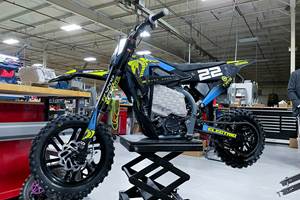Additive Manufacturing, Phase 2
Welcome to the new Additive Manufacturing magazine. And welcome to the new period of informed interest in additive as an answer to production challenges.
Share
Read Next
The conversation surrounding additive manufacturing has changed. As recently as last year’s International Manufacturing Technology Show (IMTS), I was still hearing manufacturing professionals wondering whether additive manufacturing would take the place of machining, or even boldly asserting that it would. Now, from manufacturers, I don’t hear that anymore.
The story is still pervasive. Investors, technology writers and reporters who take an uninformed interest in 3D printing still misrepresent the promise of additive manufacturing, speculating that it will edge out machining, molding and other traditional production processes, and even do so soon. But that’s not additive manufacturing’s role.
Instead, AM will enable the creation of part designs we are not conceiving of today, because they have not been possible to produce until now. Parts with intricate internal features or embedded components, parts replacing an elaborate assembly with a single piece, and customized tooling produced quickly are all among the possibilities that additive is bringing about. And I find that manufacturers today have become knowledgeable enough about additive manufacturing that they are looking to it with these kinds of possibilities in mind. That is, they no longer see it as a potential alternative or adversary to their current capabilities, but instead recognize it as a complement to what they can do today—and a powerful complement at that. With additive manufacturing, many designs become possible, practical or profitable that previously would have been unthinkable.
One other observer has seen something similar. Dr. Timothy Simpson, co-director of an additive manufacturing demonstration facility at Penn State University called CIMP-3D, recently told me that, as of two years ago, he would routinely get basic questions about additive manufacturing even from engineers touring his site. But now, he says, the engineers who visit often have a focused intent in mind. They know additive can help them, and they are seeking to build test parts and gather other evidence to make the case to their superiors for an additive approach.
The magazine you are reading is intended for this new phase of interest. We have been publishing Additive Manufacturing for three years now as a small supplement to larger magazines, but with this issue we have redesigned AM and expanded it into a larger magazine in its own right. The interest and the activity we continue to encounter in additive manufacturing easily justify this growth. However, I believe you will also find more subtle changes in this issue that go beyond the size and appearance. We (the magazine’s staff) recognize that we now speak to an audience that is far more aware of additive processes than the audience we started with when this publication began. Accordingly, if there was ever a time to introduce additive technology as something brand new and unfamiliar to manufacturers, or if there was ever a time to urge manufacturers to awaken to additive as a previously unseen option, then that time is past
Instead, let’s take the next step. Additive manufacturing offers tremendous promise in various areas. It also faces serious technical challenges and obstacles to adoption. Let’s squarely explore all of this.
And let’s also watch what happens. Personally, I am interested to see what comes next. What will the industrial landscape look like after some of those engineers pursuing additive manufacturing today succeed in making the case for it? The current moment is perhaps phase 2 in the advance of additive manufacturing. By phase 3 or 4, we might find ourselves taking it for granted that plenty of production parts are made this way.
Related Content
Large-Format “Cold” 3D Printing With Polypropylene and Polyethylene
Israeli startup Largix has developed a production solution that can 3D print PP and PE without melting them. Its first test? Custom tanks for chemical storage.
Read MoreNew Electric Dirt Bike Is Designed for Molding, but Produced Through 3D Printing (Includes Video)
Cobra Moto’s new all-electric youth motocross bike could not wait for mold tooling. Parts have been designed so they can be molded eventually, but to get the bike to market, the production method now is additive manufacturing.
Read MoreHow to Build 10,000+ Shot Molds in Hours
Rapid tooling isn’t so rapid when it takes days to 3D print a metal mold, and then you still must machine it to reach the necessary tolerances. With Nexa3D’s polymer process you can print a mold in hours that is prototype or production ready and can last for more than 10,000 shots.
Read MoreMultimaterial 3D Printing Enables Solid State Batteries
By combining different 3D printing processes and materials in a single layer, Sakuu’s Kavian platform can produce batteries for electric vehicles and other applications with twice the energy density and greater safety than traditional lithium-ion solutions.
Read MoreRead Next
Hybrid Additive Manufacturing Machine Tools Continue to Make Gains (Includes Video)
The hybrid machine tool is an idea that continues to advance. Two important developments of recent years expand the possibilities for this platform.
Read More4 Ways the Education and Training Challenge Is Different for Additive Manufacturing
The advance of additive manufacturing means we need more professionals educated in AM technology.
Read MoreAt General Atomics, Do Unmanned Aerial Systems Reveal the Future of Aircraft Manufacturing?
The maker of the Predator and SkyGuardian remote aircraft can implement additive manufacturing more rapidly and widely than the makers of other types of planes. The role of 3D printing in current and future UAS components hints at how far AM can go to save cost and time in aircraft production and design.
Read More


















